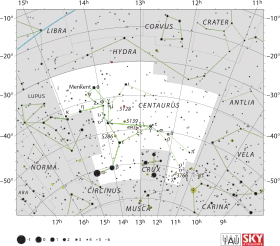Theta Centauri
Theta Centauri (θ Centauri, abbreviated Theta Cen, θ Cen), officially named Menkent /ˈmɛŋkɛnt/,[10][11] is a star in the southern constellation of Centaurus, the centaur. With an apparent visual magnitude of +2.06,[2] it is the fourth-brightest member of the constellation. Based on parallax measurements obtained during the Hipparcos mission, it is about 58.8 light-years (18.0 parsecs) distant from the Sun.[1]

| |
| Observation data Epoch J2000.0 Equinox J2000.0 | |
|---|---|
| Constellation | Centaurus |
| Right ascension | 14h 06m 40.94752s[1] |
| Declination | –36° 22′ 11.8371″[1] |
| Apparent magnitude (V) | +2.06[2] |
| Characteristics | |
| Spectral type | K0 III[3] |
| U−B color index | +0.90[2] |
| B−V color index | +0.99[2] |
| Astrometry | |
| Radial velocity (Rv) | +1.3[4] km/s |
| Proper motion (μ) | RA: –520.53[1] mas/yr Dec.: –518.06[1] mas/yr |
| Parallax (π) | 55.45 ± 0.20[1] mas |
| Distance | 58.8 ± 0.2 ly (18.03 ± 0.07 pc) |
| Absolute magnitude (MV) | 0.87[5] |
| Details | |
| Radius | 10.6[6] R☉ |
| Luminosity | 60[7] L☉ |
| Surface gravity (log g) | 2.75[8] cgs |
| Temperature | 4,980[8] K |
| Metallicity [Fe/H] | 0.03[8] dex |
| Other designations | |
| Database references | |
| SIMBAD | data |
Nomenclature
θ Centauri (Latinised to Theta Centauri) is the star's Bayer designation.
It bore the traditional name of Menkent derived from an Arabic word for "shoulder" (of the Centaur) attached to the Latin abbreviation for "kentaurus" (centaur).[7] In 2016, the International Astronomical Union organized a Working Group on Star Names (WGSN)[12] to catalog and standardize proper names for stars. The WGSN approved the name Menkent for this star on 21 August 2016 and it is now so included in the List of IAU-approved Star Names.[11]
In Chinese, 庫樓 (Kù Lóu), meaning arsenal, refers to an asterism consisting of Theta Centauri, Zeta Centauri, Eta Centauri, 2 Centauri, HD 117440, Xi¹ Centauri, Gamma Centauri, Tau Centauri, D Centauri and Sigma Centauri.[13] Consequently, the Chinese name for Theta Centauri itself is 庫樓三 (Kù Lóu sān, English: the Third Star of Arsenal).[14]
Properties
This is an evolved giant star with a stellar classification of K0 III.[3] The interferometry-measured angular diameter of this star, after correcting for limb darkening, is 5.46 ± 0.06 milliarcseconds,[15] which, at its estimated distance, equates to a physical radius of about 10.6 times the radius of the Sun.[6] The outer envelope has an effective temperature of 4,980 K,[8] giving it the orange-hued glow of a cool, K-type star.[16] Soft X-ray emission has been detected from this star, which has an estimated X-ray luminosity of 1.4 × 1027 erg s−1.[17]
References
- van Leeuwen, F. (November 2007). "Validation of the new Hipparcos reduction". Astronomy and Astrophysics. 474 (2): 653–664. arXiv:0708.1752. Bibcode:2007A&A...474..653V. doi:10.1051/0004-6361:20078357. S2CID 18759600.
- Johnson, H. L.; et al. (1966). "UBVRIJKL photometry of the bright stars". Communications of the Lunar and Planetary Laboratory. 4 (99): 99. Bibcode:1966CoLPL...4...99J.
- Gray, R. O.; et al. (July 2006), "Contributions to the Nearby Stars (NStars) Project: Spectroscopy of Stars Earlier than M0 within 40 parsecs: The Northern Sample I", The Astronomical Journal, 132 (1): 161–170, arXiv:astro-ph/0603770, Bibcode:2006AJ....132..161G, doi:10.1086/504637, S2CID 119476992
- Wielen, R.; et al. (1999), "Sixth Catalogue of Fundamental Stars (FK6). Part I. Basic fundamental stars with direct solutions", Veröff. Astron. Rechen-Inst. Heidelb, Astronomisches Rechen-Institut Heidelberg, 35 (35): 1, Bibcode:1999VeARI..35....1W
- Elgarøy, Øystein; Engvold, Oddbjørn; Lund, Niels (March 1999), "The Wilson-Bappu effect of the MgII K line - dependence on stellar temperature, activity and metallicity", Astronomy and Astrophysics, 343: 222–228, Bibcode:1999A&A...343..222E
- Lang, Kenneth R. (2006), Astrophysical formulae, Astronomy and astrophysics library, 1 (3rd ed.), Birkhäuser, ISBN 3-540-29692-1. The radius (R*) is given by:
- Kaler, James B., "MENKENT (Theta Centauri)", Stars, University of Illinois, retrieved 2012-03-01
- Jones, K. L.; et al. (June 1992), "Spectroscopic investigation of cool giants and the authenticity of their reported microwave emission", Monthly Notices of the Royal Astronomical Society, 256 (3): 535–544, Bibcode:1992MNRAS.256..535J, doi:10.1093/mnras/256.3.535
- "tet Cen". SIMBAD. Centre de données astronomiques de Strasbourg. Retrieved 2012-03-01.
- Kunitzsch, Paul; Smart, Tim (2006). A Dictionary of Modern star Names: A Short Guide to 254 Star Names and Their Derivations (2nd rev. ed.). Cambridge, Massachusetts: Sky Pub. ISBN 978-1-931559-44-7.
- "Naming Stars". IAU.org. Retrieved 18 June 2018.
- "IAU Working Group on Star Names (WGSN)". Retrieved 22 May 2016.
- (in Chinese) 中國星座神話, written by 陳久金. Published by 台灣書房出版有限公司, 2005, ISBN 978-986-7332-25-7.
- (in Chinese) 香港太空館 - 研究資源 - 亮星中英對照表 Archived 2011-01-30 at the Wayback Machine, Hong Kong Space Museum. Accessed on line November 23, 2010.
- Richichi, A.; Percheron, I.; Khristoforova, M. (February 2005), "CHARM2: An updated Catalog of High Angular Resolution Measurements", Astronomy and Astrophysics, 431 (2): 773–777, Bibcode:2005A&A...431..773R, doi:10.1051/0004-6361:20042039
- "The Colour of Stars", Australia Telescope, Outreach and Education, Commonwealth Scientific and Industrial Research Organisation, December 21, 2004, retrieved 2012-01-16
- Schroeder, K.-P.; Huensch, M.; Schmitt, J. H. M. M. (July 1998), "X-ray activity and evolutionary status of late-type giants", Astronomy and Astrophysics, 335: 591–595, Bibcode:1998A&A...335..591S